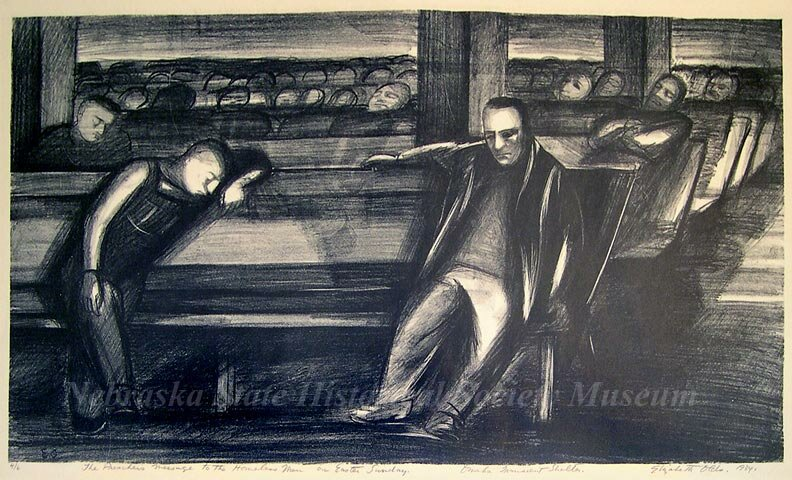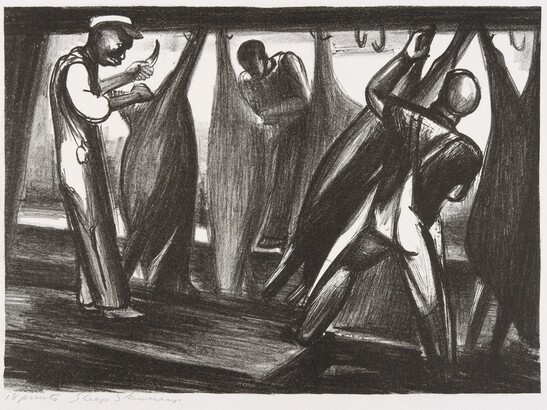Elizabeth Olds: Drawing the Great Depression in Omaha
By Natalie Kammerer
Elizabeth Olds (1896-1991) was an American artist whose career spanned several genres, media, and geographic locations. She was born in Minneapolis, studied in Minneapolis, New York, and Paris. In 1926, she was the first female artist awarded a Guggenheim Fellowship.[1]
But in the few years shortly after her return from Europe, she spent a handful of very productive years in Omaha. Olds, who was already a well-respected name at this time, had returned to the United States close to the beginning of the Great Depression. In 1932, she travelled to Omaha to paint portraits of the family of Samuel Rees Jr., then owner of the Rees Printing Company.[2] After that project, she stayed on in Omaha, first learning the basics of lithography from Rees’s technical supervisor, and then as an employee of the federal Public Works of Art Project (PWAP), where she helped to document the Depression in Omaha.[3]

Elizabeth Olds, The Preacher’s Message to the Homeless Men, 1930s. Image source: https://www.nebraskahistory.org/exhibits/new_deal_art/index.htm

Elizabeth Olds, CWA Dental Clinic, 1930s. Image source: https://www.nebraskahistory.org/exhibits/new_deal_art/index.htm
By 1934, Olds’ work was focused more pointedly on industrialism and its local manifestations. In preparation for a lithographic sequence on Omaha’s meatpacking industry, she visited the killing floors at the Swift & Co. Packing Plant in South Omaha. She sketched men working in their various roles, creating a ten-part collection called the Stockyard Series featuring works with titles like The Sheep Skinners, Beef Luggers, and Workers on the Floor. In an Omaha World-Herald article detailing the visit, she was quoted saying: “I think the luggers are the most interesting subjects in the packing house… These men, who carry great, heavy ‘quarters’ of beef into the refrigerator cars, are powerful, massive men—beautiful to see. Each wears a muslin smock that somehow winds around his head to protect him from the beef, which he carries on a shoulder. It makes him look like some sort of Turkish dignitary.”[4]

Elizabeth Olds, The Sheep Skinners from The Stockyard Series, 1934. Image source: https://www.cartermuseum.org/collection/sheep-skinners-1998106

Elizabeth Olds, Beef Skinner #2 from The Stockyard Series, 1934. Image source: https://www.cartermuseum.org/collection/beef-skinner-2-1998103
The Sheep Skinners was included in a touring collection entitled “Fifty Best Prints of 1934” organized by the Wehye Gallery of New York. Since her earliest days as a young artist studying under George Luks (Ashcan School) at the Art Students’ League in New York, Olds had been interested in frank portrayals of everyday people in unglamorous circumstances. She embraced printmaking and the skills she had picked up in Omaha helped her as a way to “introduce original modern art, inexpensively, to ordinary people.”[5] She was a strong advocate for meaningful art, writing: “Opposition is the encouragement of the hardy and a mark in favor of a strong work of art… Let the public cast aside outworn pictures as ‘decoration,’ and stop filling their homes with crumbling furniture, ‘ancestors by purchase,’ and put instead on their walls a reflection of life as vital as they themselves are.”[6]
A few months later, her lithograph titled “Dying Gangster” was awarded second place in the Kansas City Art Institute’s annual Midwestern Exposition. Shortly after, she returned to New York City, where she continued working in the WPA’s Graphic Arts Division, this time in an instructional capacity, helping younger artists develop their printmaking skills.[7] She and fellow artist Harry Gottlieb established the Silk Screen School in 1939 to teach this new technique and experiment with it as a fine art medium. Throughout her career, she continued to experiment with new media, exploring new ways to depict industrialism and American lives. She published work in political magazines including The New Masses and The New Republic, as well as writing and illustrating a number of children’s books.
[1] Langa, Helen. “Elizabeth Olds: Gender Difference and Indifference.” Woman’s Art Journal, Vol. 2, No. 22. pp. 5-11. https://www.jstor.org/stable/1358896
[2] Polk City Directory, Omaha. 1932.
[3] Langa, Helen. “Elizabeth Olds: Gender Difference and Indifference.” Woman’s Art Journal, Vol. 2, No. 22. pp. 5-11. https://www.jstor.org/stable/1358896
[4] Pinkerton, William. “A Woman on the ‘Killing Floor.’” Omaha World-Herald, February 17, 1935. p. 8.
[5] Olds, Elizabeth. “’The Old Mad Hatter’ Found Art in the Slums.” Omaha World-Herald. January 27, 1935. p. 8.
[6] Pinkerton, William. “A Woman on the ‘Killing Floor.’” Omaha World-Herald, February 17, 1935. p. 8.
[7] Langa, Helen. “Elizabeth Olds: Gender Difference and Indifference.” Woman’s Art Journal, Vol. 2, No. 22. pp. 5-11. https://www.jstor.org/stable/1358896